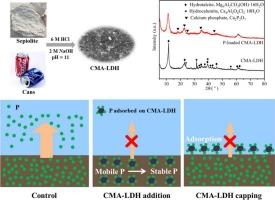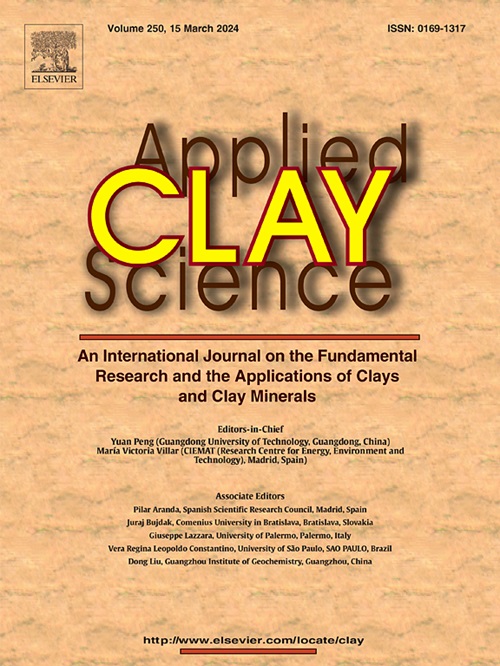Blocking endogenous phosphorus release in sediments by a hydrotalcite mixture synthesized with natural sepiolite and discarded cans
IF 5.3
2区 地球科学
Q2 CHEMISTRY, PHYSICAL
引用次数: 0
Abstract
Pure hydrotalcite (LDH) materials prepared from chemical reagents have been investigated as solid-phase phosphorus (P) inactivation materials (SPIM) to manage endogenous P loading in sediments. However, the efficacy and mechanism of LDH mixtures prepared by natural minerals and solid wastes in controlling sediment P release are unclear. Therefore, a Ca/Mg-Al-LDH (CMA-LDH) material was synthesized using sepiolite and cans, and its efficacy, mechanism, and ecological impact in controlling sediment P release were investigated. CMA-LDH-p was prepared as a control material using pure chemical reagents. The CMA-LDH and CMA-LDH-p were both composed of hydrotalcite and hydrocalumite. The maximum P adsorption capacity of CMA-LDH was 123.01 mg/g, comparable to that of CMA-LDH-p. The adsorbed P by CMA-LDH was mostly in the stable P form, accounting for 87.2 % of the total P. The adsorption capacity and immobilization ability of CMA-LDH for P were superior to other reported LDH-based SPIM. Both the CMA-LDH addition and capping successfully blocked sediment P release under anaerobic conditions. Passivation of mobile P in the sediment and DGT-labile P in the interstitial water was critical to preventing sediment P release by the CMA-LDH addition. The CMA-LDH capping inhibited sediment P release through the effective adsorption of CMA-LDH on DGT-labile P at the sediment/overlying water interface. The CMA-LDH addition and capping affected the abundance of microbial communities associated with iron and sulfur cycling, which might affect the stability of endogenous P. These results confirmed that CMA-LDH addition and capping treatments were effective methods for managing sediment P loading.

用天然海泡石和废弃易拉罐合成的水滑石混合物阻止沉积物中内源性磷的释放
由化学试剂制备的纯水滑石(LDH)材料已被研究用作固相磷(P)失活材料(SPIM),以管理沉积物中的内源磷负荷。然而,天然矿物和固体废弃物制备的 LDH 混合物在控制沉积物磷释放方面的功效和机制尚不清楚。因此,研究人员利用海泡石和罐头合成了一种 Ca/Mg-Al-LDH (CMA-LDH)材料,并研究了它在控制沉积物 P 释放方面的功效、机理和生态影响。使用纯化学试剂制备了 CMA-LDH-p 作为对照材料。CMA-LDH 和 CMA-LDH-p 均由水滑石和氢铝土组成。CMA-LDH 的最大 P 吸附量为 123.01 mg/g,与 CMA-LDH-p 相当。CMA-LDH 对磷的吸附容量和固定能力均优于其他已报道的基于 LDH 的 SPIM。在厌氧条件下,CMA-LDH 的添加和封盖都成功阻止了沉积物中 P 的释放。钝化沉积物中的可移动磷和间隙水中的 DGT 标记磷对防止 CMA-LDH 添加后沉积物中磷的释放至关重要。通过 CMA-LDH 在沉积物/上覆水体界面上对 DGT 标记 P 的有效吸附,CMA-LDH 封盖抑制了沉积物 P 的释放。这些结果证实了 CMA-LDH 添加和加盖处理是管理沉积物 P 负荷的有效方法。
本文章由计算机程序翻译,如有差异,请以英文原文为准。
求助全文
约1分钟内获得全文
求助全文
来源期刊

Applied Clay Science
地学-矿物学
CiteScore
10.30
自引率
10.70%
发文量
289
审稿时长
39 days
期刊介绍:
Applied Clay Science aims to be an international journal attracting high quality scientific papers on clays and clay minerals, including research papers, reviews, and technical notes. The journal covers typical subjects of Fundamental and Applied Clay Science such as:
• Synthesis and purification
• Structural, crystallographic and mineralogical properties of clays and clay minerals
• Thermal properties of clays and clay minerals
• Physico-chemical properties including i) surface and interface properties; ii) thermodynamic properties; iii) mechanical properties
• Interaction with water, with polar and apolar molecules
• Colloidal properties and rheology
• Adsorption, Intercalation, Ionic exchange
• Genesis and deposits of clay minerals
• Geology and geochemistry of clays
• Modification of clays and clay minerals properties by thermal and physical treatments
• Modification by chemical treatments with organic and inorganic molecules(organoclays, pillared clays)
• Modification by biological microorganisms. etc...
 求助内容:
求助内容: 应助结果提醒方式:
应助结果提醒方式:


